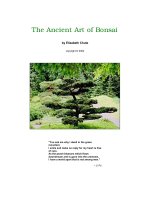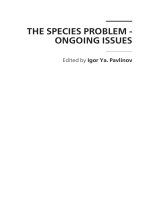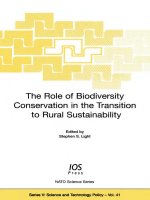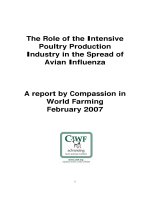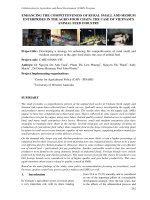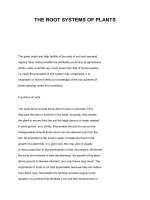The Aral Sea Encyclopedia - E pptx
Bạn đang xem bản rút gọn của tài liệu. Xem và tải ngay bản đầy đủ của tài liệu tại đây (118.41 KB, 3 trang )
E
Eastern (Aral) Sea – the remaining part of A.S. located to the east of the merged
chain of the Vozrozhdenia (see), Lazareva (see) and Komsomolsky (see) Islands
is referred to in this way in scientific literature.
Ecological-geographical database of the Aral Sea basin – developed by the
Laboratory of Land Ecosystem Dynamics of the RAS Institute of Water
Problems for monitoring of the natural ecosystems in the A.S. basin. The
database was prepared using the results of expedition research and also data
of stationary and semistationary observations received for the period
1978–1997. The data from the published works of foundations and archives
for 1947–1994 were also included into this database as literary sources. The
relevant hydrometeorological information received by hydraulic and meteor-
ological stations located in the Amudarya and Syrdarya basin was also used. All
data were subject to preliminary analysis and processing and were converted
into a standard form for input, storage, and further utilization for addressing a
wide spectrum of environmental issues.
The database includes several thematic sections reflecting the condition of
the ecosystem’s basic components – soils, vegetation, clim ate, surface, and
groundwaters. All sections are interrelated and provided with a reference-
information system. The geographical database is based on the scheme of
landscape-typological zoning with a multilevel hierarchical system of units.
This scheme was used for identification of the Amudarya and Syrdarya basin
and the drainless areas in the Karakums and Kyzylkums in the territory of the
A.S. watershed. Each river basin is divided into functional parts: watershed,
floodplain, mountain, plain, and delta.
Ecological map of the circum-Aral area – published in 1991 in Almaty.
Ecological refugees – people whose lives were at risk or whose quality of life
was seriously affected and were forced to leave their residences due to envir-
onmental disturbances. Three categories of E.R. are distinguished: first, peo-
ple who leave their residences temporarily due to environmental stress
(natural events); second, people who leave their residences for good and
resettle to new places (the result of construction of large reservoirs, etc.);
I.S. Zonn et al., The Aral Sea Encyclopedia, DOI 10.1007/978-3-540-85088-5_6,
Ó Springer-Verlag Berlin Heidelberg 2009
91
and third, people or groups of people that migrate from their residences,
either permanently or from time to time, to a new area within a country or
abroad in search of better living conditions (in ecological terms). Due to the
Aral’s drying out, a part of the Karakalpak population became Ecological
Refugees.
Ecological research and monitoring of the Aral Sea deltas – interdisciplinary
project of UNESCO initiated in 1994 with the financial support of the Federal
Ministry for Research and Technology, Germany. The project united 130
scientists and specialists on the Aral region.
Ekzek Bay* – juts for 6.5 km into the western shore of the Small Aral Sea (see)
20 km to the south-west of the Tarangly Cape. The bay is shallow. The fishery
area Shemyshkol (now closed) was found on the southern shore of the bay.
Encyclopedia of the Aral Sea – book by I.S. Zonn and M. Glantz (edited by
A.N. Kosarev and A.G. Kostianoy) and published in the Russian edition
in 2008.
Encyclopedia of Islam – the work of V. Bartold (see) published in German in the
early 2 0th century. It includes 111 h istorica l-geo graphi cal entries desc ribing a vast
territory from the Crimea and Povolzhie to Mongolia. Among them are articles on
the ‘‘Aral Sea’’ and ‘‘ Amu Darya.’’ This work was translated into Russian and
presented i n t he book, ‘‘Works o n Historical Geography,’’ by V.V. Bartold, and
published in ‘‘Oriental Literature’’ by the Russian Academy of Sciences in Moscow
in 2002.
Environmental crisis – the global change of the environment leading to dis-
turbances of the natural conditions for the existence of modern forms of life
on the Earth and the established dynamic equilibrium in the biosphere in
general. The report of the UN Environmental Program of 1992, referring to
the Aral Sea crisis, states, ‘‘we can hardly find any other region on our planet,
except may be C hernobyl, where a more severe environmental crisis affected
such a large territory and interfered with the life of such a large number
of people.’’
Erzhan Island* – located to the west of the Djalpakkair strait (see) along the
southeastern coast of A.S. in the center of the Zhiltyrbas Bay (see) and to the
southeast of the Uzynkair Cape. The island is low and sandy. Due to sea water
level fluctuations the coastline is subject to sharp changes.
Executive Committee of the International Fund for saving the Aral Sea (IFAS) –
established in 1997 as the permanent executive and managing body of
IFAS in Tashkent having branches in all states of Central Asia. The
Executive Committee is a legal entity with the status of an international
organization. The IFAS Executive Committee has its own running and
settlement accounts in national and foreign currencies for supporting its
activities and collects contributions from founding states, international
92 E Ecological research and monitoring of the Aral Sea deltas
organizations, donor countries, grants, charities, as well as other donations
from legal entities and private persons for the implementation of programs
and projects and the distribution of urgent aid to the population i n the
A.S. basin.
Executive Committee of the International Fund E 93


